Stef Bundle
How did STEF S.A. become a European cold chain giant?
Journey back in time to uncover the Stef SWOT Analysis and explore the remarkable Stef Company history! This century-old story of Stef Company background reveals how a company, initially focused on ensuring food supplies, evolved into a leader in temperature-controlled logistics. Discover the pivotal moments and strategic decisions that shaped STEF's impressive growth and resilience.
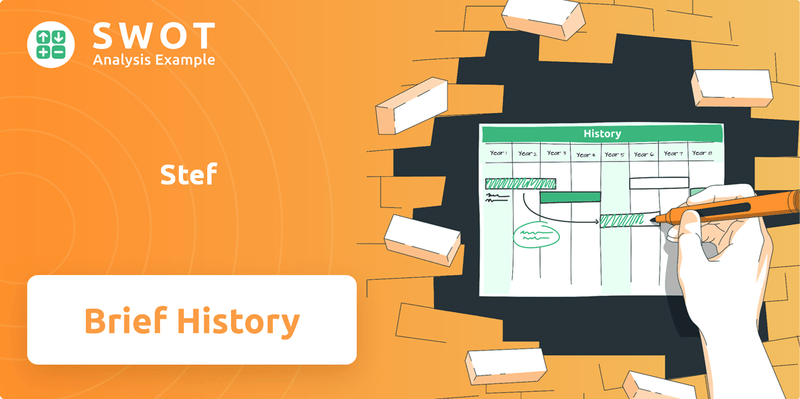
From its humble beginnings in 1920, the Stef Company timeline is a testament to its adaptability and forward-thinking approach. Understanding the Stef Company founder's vision and the company's early services provides crucial context. Examining Stef Company milestones and its Stef Company evolution offers valuable insights into its strategic choices and sustained success in a dynamic market.
What is the Stef Founding Story?
The Stef Company history began in 1920, marking its inception as Société Française de Transports et Entrepôts Frigorifiques. This founding was a direct response to the post-World War I era, driven by the critical need to import frozen meat to feed the French population. The establishment of Stef Company background was a strategic move by the PLM company (Paris, Lyon, Marseille) to ensure a reliable food supply chain.
The early days of Stef Company focused on temperature-controlled transport and storage. This was achieved through a network of wagons and warehouses. The company's evolution included the establishment of a technical department in 1930, which adapted to various products. This led to the fitting out of wagons, including the first tanker wagons for transporting fresh milk. This early focus showcases the company's commitment to innovation and adaptation.
In 1938, Stef Company milestones included its acquisition and becoming a subsidiary of SNCF, the French national rail network. This integration into the national transport infrastructure provided a solid foundation for the company's early operations and expansion. The company's initial services were centered around cold transport and warehousing, addressing the essential need for food preservation and distribution. The company's growth strategy in the early years was focused on expanding its capacity and adapting its services to meet the evolving needs of the food industry.
The Stef Company timeline shows a clear evolution from its founding to its integration within the French transport infrastructure.
- 1920: Foundation of Société Française de Transports et Entrepôts Frigorifiques.
- 1930: Establishment of a technical department for adapting to various products.
- 1938: Acquisition by and becoming a subsidiary of SNCF.
Stef SWOT Analysis
- Complete SWOT Breakdown
- Fully Customizable
- Editable in Excel & Word
- Professional Formatting
- Investor-Ready Format
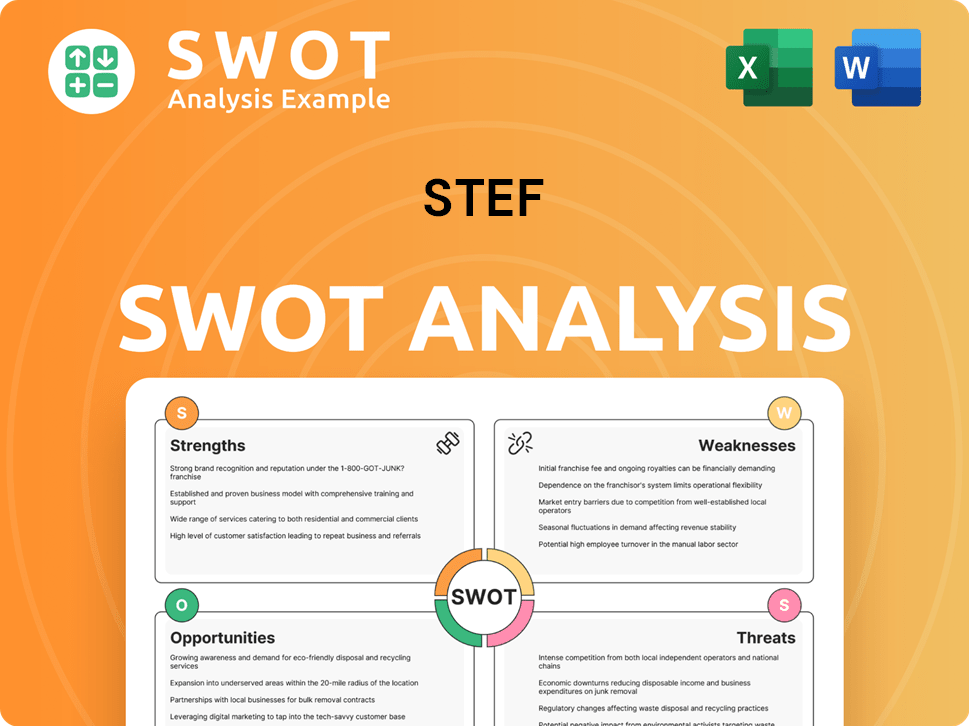
What Drove the Early Growth of Stef?
The early growth and expansion of the company, now known as STEF, showcase a remarkable adaptation to the changing transport landscape and evolving consumer needs. From its origins, the company strategically shifted towards road transport, responding to the development of road networks. This period witnessed significant innovations and strategic acquisitions, laying the groundwork for its future success. The company's Target Market of Stef has consistently evolved.
Following its acquisition by SNCF in 1938, the company began a significant shift towards road transport, especially with the expansion of road networks in the 1950s. Between 1950 and 1954, the company ordered 135 new types of trailers, demonstrating a strategic pivot. Innovations like the introduction of the first icing towers in 1953 enhanced its cold chain capabilities.
The emergence of mass consumption in 1963, marked by the opening of France's first hypermarket, further fueled the company's growth. Refrigerated transport became crucial to serve a nationwide market. A pivotal moment was the 1964 merger of Sancier, Galopin, and Eurotransit, creating TFE, which later merged with STEF. STEF played a key role in the frozen food revolution of 1974.
A turning point was the company's independence from SNCF in 1987. The 1990s saw substantial European expansion, with operations established in Belgium, Spain, and Portugal. The merger of STEF and the TFE groupage network created STEF-TFE. The company adopted an employee share ownership program, central to its independence strategy.
Major capital raises and acquisitions continued, including Cavalieri in Italy in 2005 and SVAT in 2022. In 2023, STEF acquired TransWest in Belgium in October and Bakker Logistiek in the Netherlands, finalized in early 2024, boosting service offerings. The company's revenue for 2023 was €4.442 billion, a 6.8% increase year-on-year. In 2024, revenue reached €4,800.8 million, an 8.1% increase compared to 2023.
Stef PESTLE Analysis
- Covers All 6 PESTLE Categories
- No Research Needed – Save Hours of Work
- Built by Experts, Trusted by Consultants
- Instant Download, Ready to Use
- 100% Editable, Fully Customizable
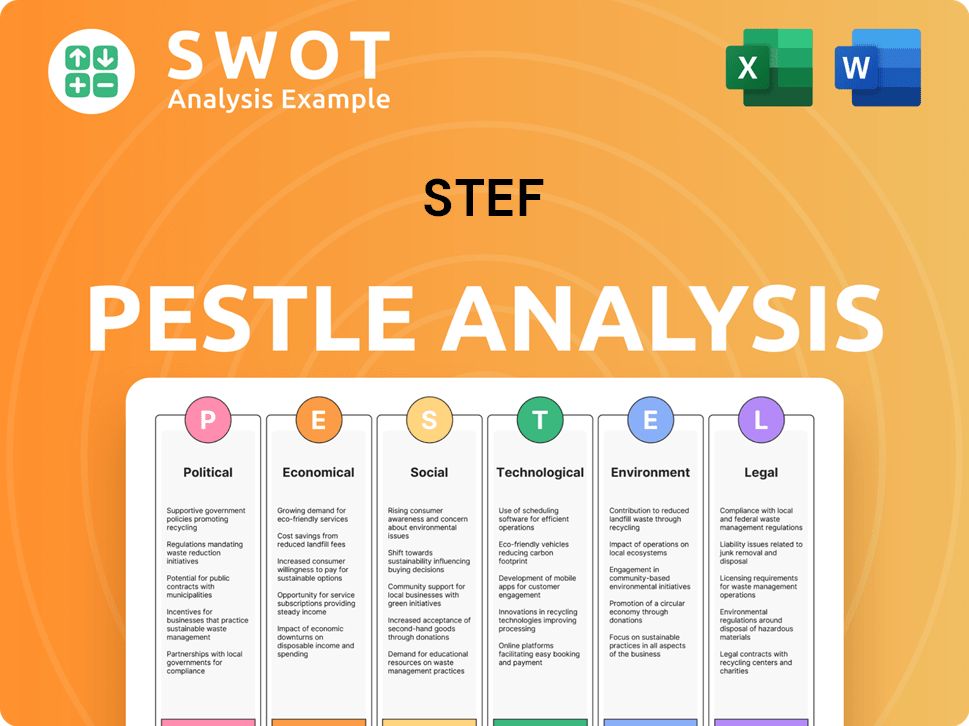
What are the key Milestones in Stef history?
The Stef Company history is marked by significant milestones that highlight its growth and adaptation in the temperature-controlled logistics sector. From its early days to its current operations, the company has consistently evolved to meet the changing needs of the food industry and beyond.
| Year | Milestone |
|---|---|
| 1930s | Development of specialized wagons, including the first tanker wagons for fresh milk, marked an early innovation in logistics. |
| 1953 | Introduction of icing towers demonstrated a commitment to advanced cold chain technology. |
| 1974 | Role in the frozen food revolution highlighted responsiveness to evolving food industry needs. |
| 1987 | Achieved independence from SNCF, a major strategic shift. |
| 2005 | Acquisition of Cavalieri in Italy, expanding its international presence. |
| 2022 | Acquisition of SVAT, further strengthening its market position. |
| 2023-Early 2024 | Acquired TransWest in Belgium and Bakker Logistiek in the Netherlands, solidifying its presence in Northern Europe. |
| December 2024 | Acquired the TDL Fresh Logistics business from TDL Group, expanding its service offerings. |
Innovation has been a cornerstone of the Stef Company's evolution, with the development of specialized transport solutions being a key focus. The company's early adoption of technologies like icing towers and its responsiveness to market changes, such as the frozen food revolution, showcase its commitment to staying ahead.
The development of specialized wagons for different products, including the first tanker wagons for fresh milk in the 1930s, was a key innovation.
The introduction of icing towers in 1953 further showcased their commitment to advanced cold chain technology.
The company's role in the frozen food revolution in 1974 highlights its responsiveness to evolving food industry needs.
Equipping sites with hydrogen-powered handling equipment in late 2024 shows commitment to green energy.
Partnering with Toyota Material Handling Europe and Plug Power for hydrogen forklift solutions in 2025 demonstrates a focus on sustainable practices.
Consistent external growth through acquisitions, such as Cavalieri in Italy in 2005, Cryologistics in France, SVAT in 2022, and Ebrex France, has strengthened its market position.
Despite its successes, the Stef Company has faced challenges, including market downturns and competitive pressures. Economic and geopolitical tensions in 2024 led to a slowdown in demand for road transport and impacted margins, posing a significant hurdle. Low food consumption in Europe, particularly in France, affected volumes in chilled products and seafood, and impacted the profitability of frozen products.
Economic and geopolitical tensions in 2024 led to a slowdown in demand for road transport, impacting margins.
Low food consumption in Europe, particularly in France, impacted volumes in chilled products and seafood, and affected the profitability of frozen products.
Internationally, while acquisitions boosted revenue, the margin rate of newly acquired companies had not yet reached STEF International's usual level due to integration time.
Italy, for instance, experienced a slowdown due to market contraction and operational difficulties.
The company faces ongoing competitive pressures within the temperature-controlled logistics sector.
The impact of economic conditions on margins remains a significant challenge.
Stef Business Model Canvas
- Complete 9-Block Business Model Canvas
- Effortlessly Communicate Your Business Strategy
- Investor-Ready BMC Format
- 100% Editable and Customizable
- Clear and Structured Layout
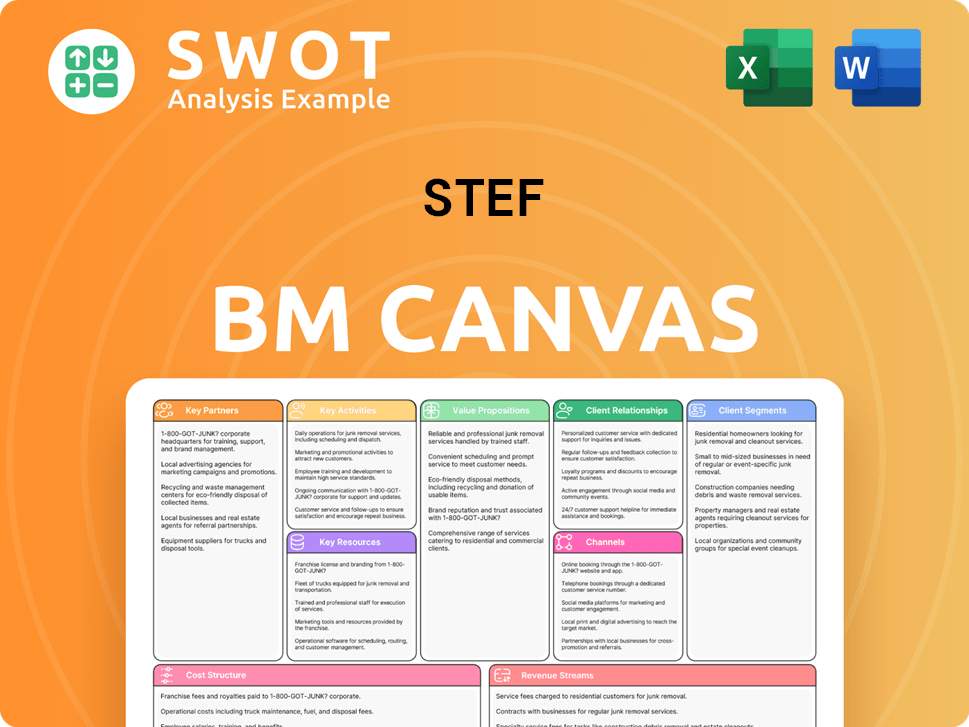
What is the Timeline of Key Events for Stef?
The Growth Strategy of Stef has been shaped by a series of pivotal moments, beginning with its founding in 1920 as Société Française de Transports et Entrepôts Frigorifiques. The company's evolution, marked by strategic shifts and expansions, has positioned it as a key player in temperature-controlled logistics. Key milestones include early technical innovations, independence from SNCF, and significant acquisitions that have fueled its expansion across Europe. The company's history reflects a consistent focus on adapting to market changes and capitalizing on growth opportunities within the food supply chain.
| Year | Key Event |
|---|---|
| 1920 | Founding of Société Française de Transports et Entrepôts Frigorifiques (STEF). |
| 1930 | Establishment of a technical department and fitting out of wagons for various products, including milk tankers. |
| 1938 | STEF is bought out and becomes a subsidiary of SNCF. |
| 1950-1954 | Strategic shift towards road transport with the order of 135 new trailers. |
| 1953 | Appearance of the first icing towers. |
| 1963 | Emergence of mass consumption marks a shift to nationwide refrigerated transport. |
| 1964 | Merger of Sancier, Galopin, and Eurotransit creates TFE. |
| 1974 | STEF plays a role in the frozen food revolution. |
| 1987 | STEF gains independence from SNCF. |
| 1990s | European expansion into Belgium, Spain, and Portugal. |
| 1998 | The STEF-TFE Group is floated on the stock market. |
| 2005 | Acquisition of Cavalieri in Italy. |
| 2012 | STEF-TFE adopts a single brand name: STEF. |
| 2022 | Consolidation of Italian presence with the acquisition of SVAT. |
| October 2023 | Acquisition of TransWest in Belgium. |
| December 2024 | Acquisition of TDL Fresh Logistics business from TDL Group. |
| Early 2024 | Finalization of the acquisition of Bakker Logistiek in the Netherlands. |
| March 2025 | Approval of 2024 financial statements, reporting €4.8 billion in revenue. |
| April 2025 | Publication of Q1 2025 revenue and 2024 annual accounts. |
STEF is focused on the second phase of its strategic plan, aiming to integrate recent acquisitions operationally and culturally. The company is committed to managing resources effectively while exploring investment opportunities.
STEF's strategy includes an ambitious inorganic growth plan to become a pure player in the European food supply chain. This involves expanding its presence through acquisitions and strategic partnerships.
The company is accelerating its transition to green energy, including the use of hydrogen-powered handling equipment. This initiative supports its commitment to environmental sustainability within its operations.
STEF maintains a policy of distributing one-third of its net profit as dividends. For the 2024 financial year, a dividend of €4.15 per share has been proposed, reflecting its commitment to shareholder returns. In March 2025, the company reported €4.8 billion in revenue.
Stef Porter's Five Forces Analysis
- Covers All 5 Competitive Forces in Detail
- Structured for Consultants, Students, and Founders
- 100% Editable in Microsoft Word & Excel
- Instant Digital Download – Use Immediately
- Compatible with Mac & PC – Fully Unlocked
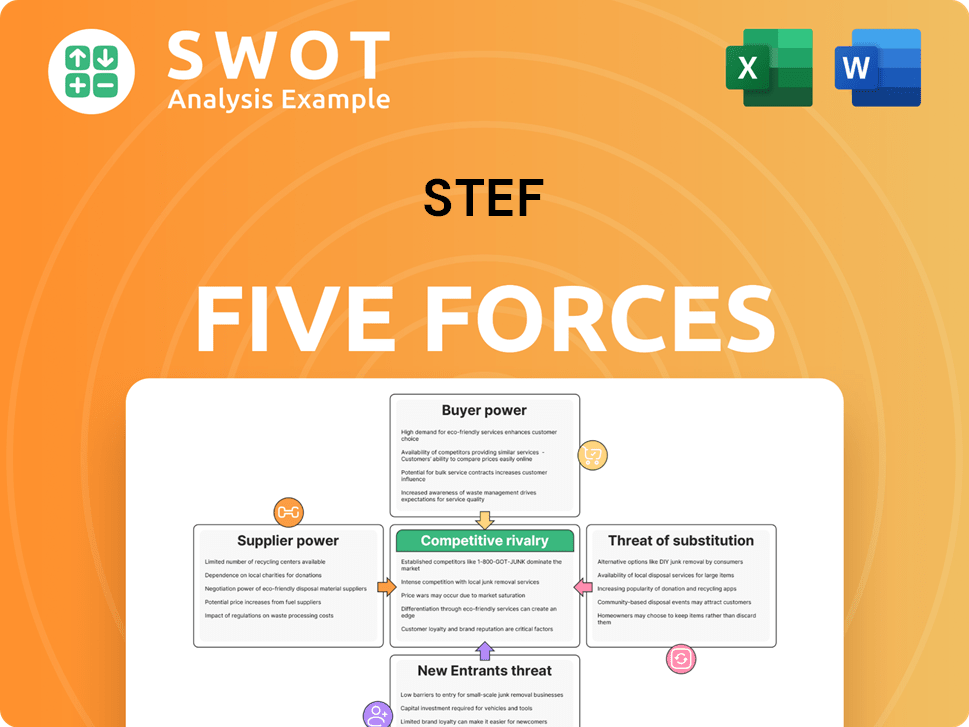
Related Blogs
- What is Competitive Landscape of Stef Company?
- What is Growth Strategy and Future Prospects of Stef Company?
- How Does Stef Company Work?
- What is Sales and Marketing Strategy of Stef Company?
- What is Brief History of Stef Company?
- Who Owns Stef Company?
- What is Customer Demographics and Target Market of Stef Company?
Disclaimer
All information, articles, and product details provided on this website are for general informational and educational purposes only. We do not claim any ownership over, nor do we intend to infringe upon, any trademarks, copyrights, logos, brand names, or other intellectual property mentioned or depicted on this site. Such intellectual property remains the property of its respective owners, and any references here are made solely for identification or informational purposes, without implying any affiliation, endorsement, or partnership.
We make no representations or warranties, express or implied, regarding the accuracy, completeness, or suitability of any content or products presented. Nothing on this website should be construed as legal, tax, investment, financial, medical, or other professional advice. In addition, no part of this site—including articles or product references—constitutes a solicitation, recommendation, endorsement, advertisement, or offer to buy or sell any securities, franchises, or other financial instruments, particularly in jurisdictions where such activity would be unlawful.
All content is of a general nature and may not address the specific circumstances of any individual or entity. It is not a substitute for professional advice or services. Any actions you take based on the information provided here are strictly at your own risk. You accept full responsibility for any decisions or outcomes arising from your use of this website and agree to release us from any liability in connection with your use of, or reliance upon, the content or products found herein.